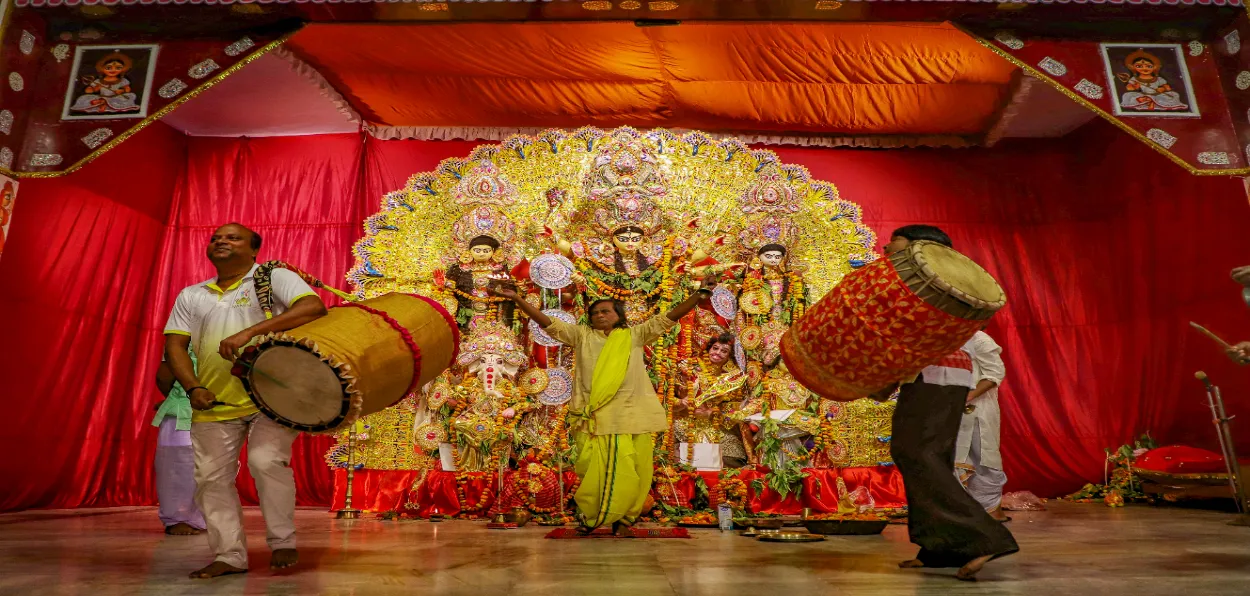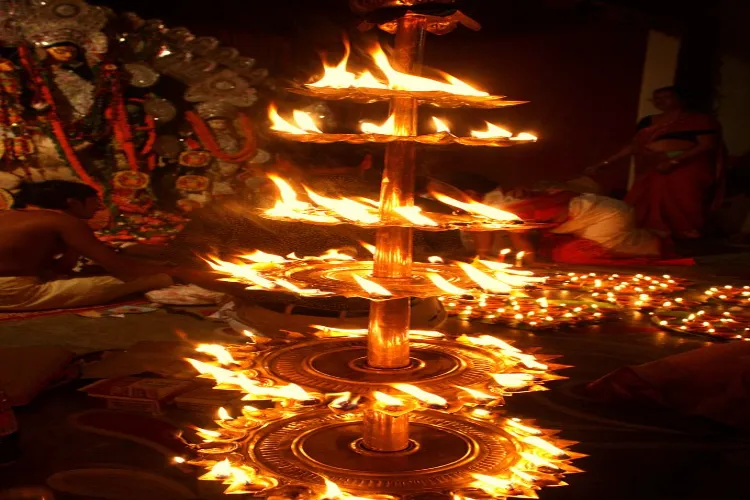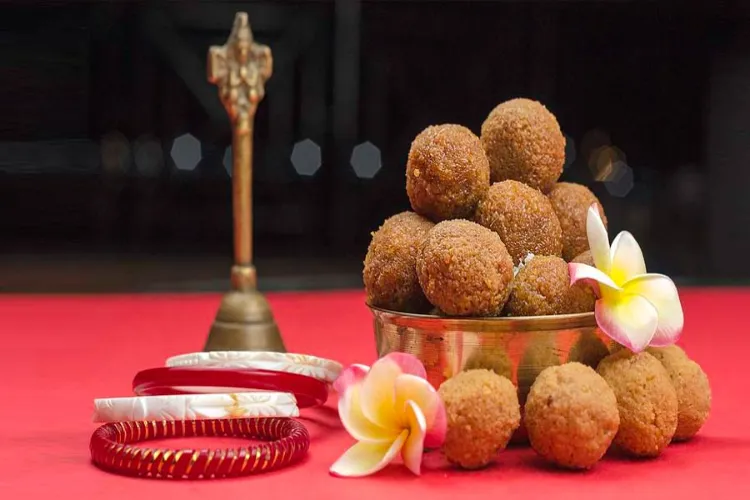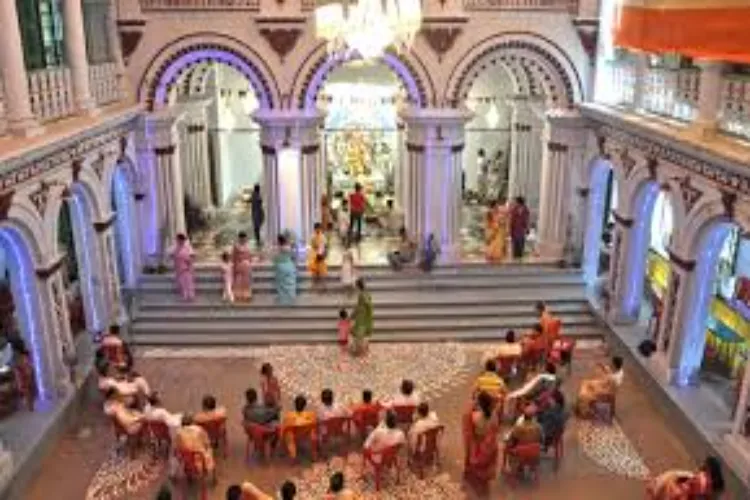
Sumana Mukherjee/New Delhi
Mahaashtami (eighth lunar day) in Durga Puja stands with utmost importance as it had decided the fate of a fierce battle between Goddess Durga and the Buffalo Demon-Mahishasura. On this day, Goddess Durga, an embodiment of strength, courage, faith, unity and valour, received the ultimate universal force within her inner being to annihilate the evils incessantly.
As per Mythology, Goddess Durga was born out of the cumulative strength of the deitie; she is the incarnation of infinite power or Shakti (Feminine divinity) capable of destroying the malicious.
Goddess started the battle against the deadly Demon Mahishasura who went on to grab hold of the heaven. It was the eighth lunar day when the battle went fiercer and then to deadlier. Mahishasura had unlimited vigour and was blessed with shape-shifting capacities.
He concealed himself inside a buffalo and his demon mates Chondo and Mundo attacked her from the back when she was battling Mahishasura.
.webp)
Divine Mother- Durga
In retribution the divinity turned into Chandika which stands for annihilation. there was a perfect moment to slay those two demons and Devi Chandika took 48 minutes to destroy them. The last 24 minutes of Mahaashtami and the first 24 minutes of Mahanavami (a total of 48 minutes between the two lunar days) constitute the Sandhi or ‘Sacred Juncture’. This holy period of transformation is the most sanctified moment when the goddess turned out to be the demolisher of evil forces. This 48-minute of Sandhi is the most pious and astonishing period of Durga puja.
It is firmly believed that whosoever performs the Mahaashtami puja receives the blessing from the divine to make the impossible possible. When Lord Sri Rama was about to get into the battle against another demon king Ravaana in Lanka (now Sri Laka), he gave up hope of winning against him because Ravana had received the boon of immortality from Lord Shiva. Then following the divine instruction Rama started worshipping Devi Durga. During the Puja rituals he arranged 108 lotus flowers without which rituals could not be completed. Somehow one lotus was less and Rama went on to offer one of his lotus shaped eyes to the divine. In the meantime, the deity appeared in front of him and stopped him. Sri Rama received the heavenly blessing of winning against Ravana.
.webp)
108 Lotus is manadatory on the day of Mahaashtami
Since then, offering 108 Lotus flowers to the Goddess is an indispensable part of the Ashtami ritual. That apart 108 lamps are lit and dry rice grain, sugar, sweets, fruits, jewellery, clothes, garlands made out of hibiscus, bel leaves (wood apple) are also offered to the deity. There is a special chant to please Devi Chandika and this tradition remained a continuous process since the ancient time.
For the uninitiated Durga Puja of Kolkata is inscribed on the list of ‘Intangible Cultural heritage of Humanity’ by the UNESCO two years ago.
According to an estimate, There were about 3,000 Pandals of Puja in Kolkata last year.of these more than 200 pujas were organized in the city with a budget of over one crore rupees
The Puja is mainly celebrated for 5 days - Shashti, Saptami, Ashtami, Navami and Dasami. But the festive mood around Durga Puja in Kolkata starts before Shashti, mainly from Mahalaya.

108 Diya fo Devi Durga Aarti
Mahaashtami Pushpanjali
‘Pushpanjali’ is offerings flowers to Maa Durga who is regarded as the protector of this creation. Pushpanjali, an integral part of Hindu rituals, takes place once during the Ashtami hours and later during the Sandhi Puja hours. Following the traditions, devotees gather in front of the Deity’s idol and they chant Vaidik Stotram (Hymns from the Vedas) along with the head priest.
Mahaashtami puja has always been very precious for the Hindus worshipping the Goddess who is the source of liveliness, supremacy and self-esteem. As a matter of fact, puja is never complete without special Puja Bhog accompanied by ritualis. The Mahaashtami Bhog is always prepared with much admired traditional rituals.
Bengal gets into great fervour on the day of Ashtami. Special Bhog is prepared to offer to the divine. Ashtami Bhog of Vaishnav rituals forbids food with onions and garlic. On this day dishes like Khichudi, (Khichdi), fried vegetables, Mixed vegetables, Chutney, Payesh (Kheer), Mishti Doi, (Sweet curd), Sweets like Rosogolla Sandesh to name a few are cooked to offer to the Goddess and then shared by the worshippers.
Khichudi Bhog is prepared with special ingredients like Govindbhog rice and Golden yellow Moong Daal. Due to its awesome combination and sacred reasons, it tastes heavenly. Devotees take it as the prasad of Ashtami puja.
.webp)
Mahashtami Bhog always comes with a special taste
A mixed vegetable item called Labra is also a delicious served along with the Khichudi. Beside, Yellow Sweet pulao, Puri, Dam Aloo (steamed potato), Cauliflower in gravy, fried potato, fried brinjal, fried cauliflower, mango chutney, tomato chutney, payesh (Kheer), traditional Bengali sweets like Rosogolla and Sandesh are among all-time favourites eaten by the Bengalis on this divine day.

Coconut Laddoo is an integral part of Durga Puja
Sandhi Puja Bhog
Sandhi Puja is a strictly time-bound process and the rituals associated with it have to be completed within 48 minutes. Normally Sandhi Puja Bhog includes Puri, Sweets, Nadu (coconut laddu), Sugar, Malpura, Fruits, Kheer etc.Ashtami Bhog offered by the Royal families
Besides the above rituals and foods associated with Durga Puja which is hugely celebrated in West Bengal and the adjoining areas of Bihar and Jharkhand as a traditon, there are special puja Bhog of the Bonedi families or the traditional Bengali families that belonged to the zamindars and state-level kings.
These families make lavish arrangements of puja inside their palatial homes and have heritage dishes cooked. Though much of the older recipies are lost there are quite some which are made on these special days.
.webp)
Shovabazar Rajbari in Kolkata offers special Bhog of Sweets to the Goddess
Shovabazar Rajbari, located at 33, Raja Naba Krishna Street, Sovabazar, Kolkata is continuing the traditions of their Durga Puja that started 233 years back.

The Royal House of The Laha Family in Kolkata
Another prominent royal family of Kolkata is Sabarna Roy Choudhury Family, located at Sakher Bazar, Subodh Pally, Barisha, Kolkata. They ofer basanti pulao with dry fruits, fried vegetables, and different kinds of fish dishe. Sabarna Roy Choudhury Family do not follow the Vaishnav rituals; another ritual called Shakto ritual is followed here.
The auspicious day of Mahaashtami has given us the blessings from the Mother Deity who is always there to empower us with her unfathomable strength and vigour.
